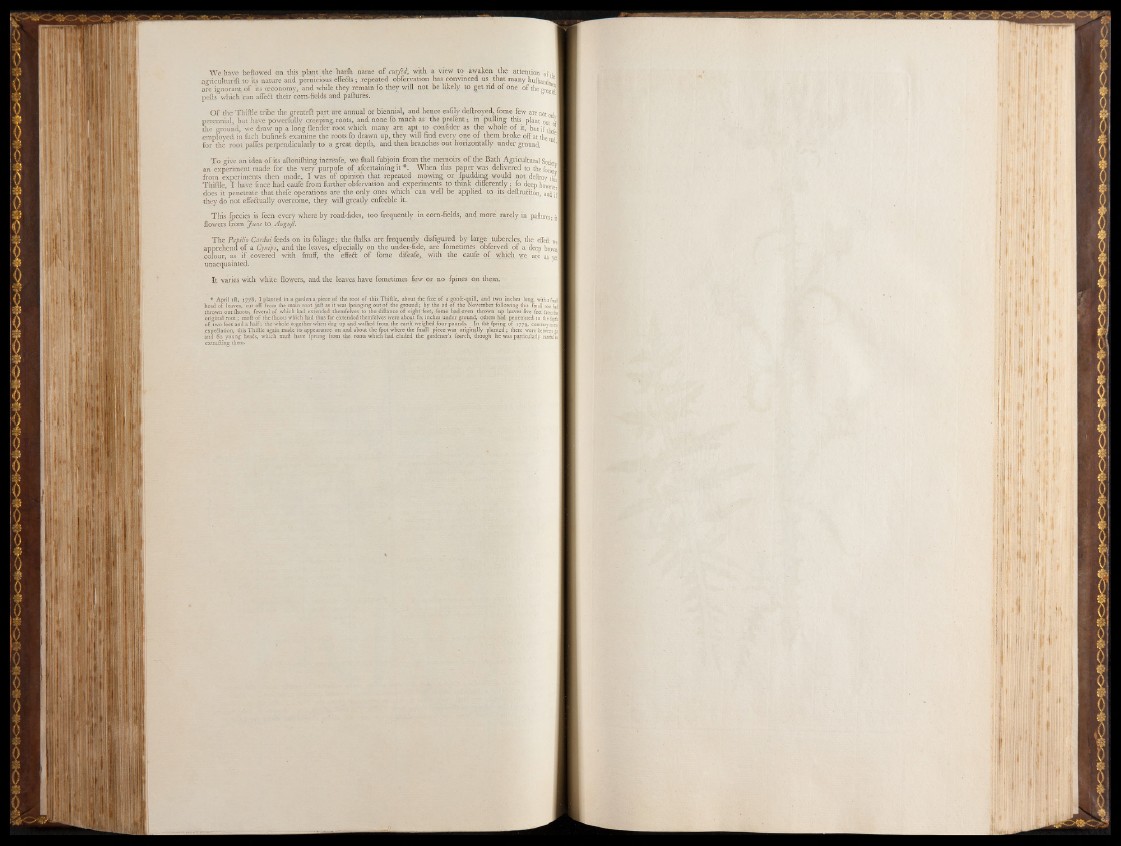
We have heftowed on this plant the harfh name of cur fed, with a view to awaken the attention 0f .lJ
agriculturift to its nature and pernicious effe&s ; xepeated obfervation has convinced us that many hufbandin I
are ignorant of its ceconomy, and while they remain fo they will not be likely to get rid of one of the great2|
pefts which can affeft their corn-fields and paftures.
O f the Thiftle tribe the greateft part are annual or biennial, and hence eafily defixoyed, fome few are not on]
perennial, but have powerfully creeping, roots, and none fo much as the prefent; in pulling this plant out Jpl
the ground, we draw up a long {lender root which many are apt . to confider as the whole of it, but if tW I
employed in fuch bufinefs examine the roots fo drawn up, they will find every one of them broke off at the end I
for the root pafles perpendicularly to a great depth, and then branches out horizontally under ground. ’I
To give an idea of its aftonifhmg increafe, we fhall fubjoin from the memoirs of the Bath Agricultural Societvl
an experiment made for the very purpofe of ^fcertaining it *. When this paper was delivered to the focietvl
from experiments then made, I was of opinion that repeated mowing or fpudding would not deftrov tll
Thiftle, I have fince had caufe from further obfervation and experiments to think differently; fo deep however!
does it penetrate that thefe operations are the only ones which can well be applied to its deftru&ion, and if I
diey do not effe&ually overcome, they will gready enfeeble it.
This fpeeies is feen every where by road-fides, too frequently in corn-fields, and more rarely in paftures- i j
flowers from June to Auguji.
The Papilio Cardui feeds on its foliage; the ftalks are frequently disfigured by large tubercles, the effeft we|
apprehend o f a Cynips, and the leaves, efpecially on the under-fide, are fomedmes obferved of a deep brown-
.colour, as if covered with fnuff, the effeft o f fome difeafe, with the caufe of which we are as yej
unacquainted*
It varies with white flowers, and the leaves, have fometimes few or no fpines on them.
* April 1 ft, 1778, I planted in a garden a piece o f the root of this Thiftle, about the fize of a goofe-quill, and two inches long, with a fmall head of leaves, cut off from the main root juft as it was fpringing out of the ground; by the ad of the November following this fmall root hail
thrown out (hoots, feveral of which had extended themfelves to the diftance of eight feet, fome had even thrown up leaves five feet from tbel
original root ; moft of the (hoots which had thus far extended themfelves were about fix inches under ground, others had penetrated to the depth jj
of two feet and a half; the whole together when dug up and walhed from the earth weighed four pounds. In the fpring of 1779, contrary to my S
expeQation,. this Thiftle again made ns appearance on and about the fpot where the fmall piece was originally planted ; there were between jo| and 60 young heads, which rauft have fprung from the roots which had eluded the gardener’s fearch, though he was particularly careful ini extra&ing them.